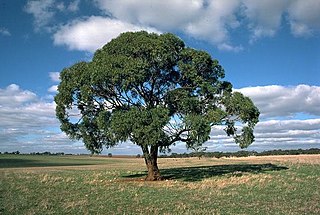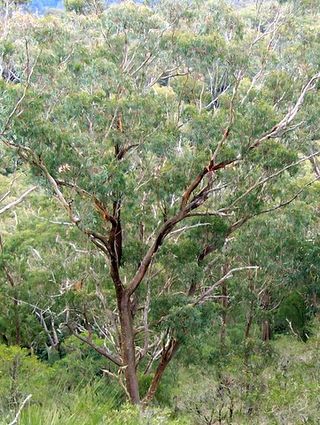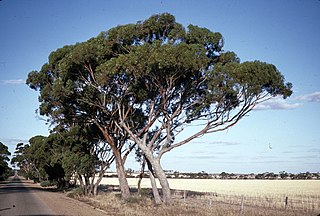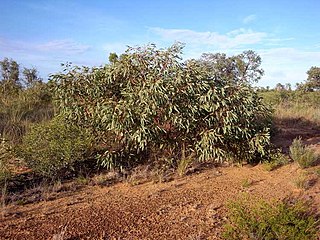
Eucalyptus radiata, commonly known as the narrow-leaved peppermint or Forth River peppermint, is a species of tree that is endemic to south-eastern Australia. It has rough, fibrous to flaky bark on the trunk and larger branches, smooth grey bark on the thinner branches, lance-shaped to curved or almost linear leaves, flower buds in groups of eleven to twenty or more, white flowers and cup-shaped, hemispherical or shortened spherical fruit.

Eucalyptus elata, commonly known as the river peppermint or river white gum, is a species of medium to tall tree that is endemic to eastern Australia. It has rough, compacted bark on the lower trunk, smooth bark above, lance-shaped to curved adult leaves, green to yellow flower buds arranged in groups of eleven to thirty or more, white flowers and hemispherical or shortened spherical fruit.

Eucalyptus todtiana, commonly known as coastal blackbuttpricklybark or dwutta, is a species of tree or a mallee that is endemic to the west coast of Western Australia. It has rough, fibrous and flaky bark on the trunk, smooth bark on the branches, lance-shaped adult leaves, flower buds in groups of between seven and eleven, white flowers and cup-shaped to hemispherical fruit.

Eucalyptus odorata, commonly known as peppermint box, is a species of mallee or a small tree that is endemic to South Australia. It has rough, hard bark on the trunk and larger branches, smooth greyish bark on the thinner branches, lance-shaped adult leaves, flower buds in groups of between seven and eleven, white flowers and cylindrical or barrel-shaped fruit.

Eucalyptus campanulata, commonly known as the New England blackbutt, gum-topped peppermint or New England ash, is a tree that is endemic to eastern Australia. It has rough, finely fibrous greyish bark on the trunk and larger branches, lance-shaped to curved adult leaves, flower buds arranged in groups of between eleven and fifteen, white flowers and cup-shaped to conical fruit.

Eucalyptus nitida, commonly known as the Smithton peppermint, is a species of tree or mallee that is endemic to Tasmania. It has varying amounts of loose, fibrous or flaky bark, lance-shaped to curved adult leaves, flower buds in groups of nine to fifteen, white flowers and cup-shaped to hemispherical fruit.

Eucalyptus loxophleba, commonly known as York gum, daarwet, goatta, twotta or yandee, is a species of tree or mallee that is endemic to Western Australia. It has rough bark on the trunk, smooth olive to brownish bark above, lance-shaped adult leaves, flowers buds in groups of between seven and eleven, white flowers and conical fruit.

Eucalyptus porosa, commonly known as mallee box, Quorn mallee or water mallee, is a species of mallee or a tree that is endemic to southern Australia. It has rough, fibrous or flaky bark on the trunk and larger branches, smooth greyish bark above, lance-shaped adult leaves, flower buds in groups of seven, white flowers and barrel-shaped or shortened spherical fruit.
Eucalyptus croajingolensis, commonly known as the East Gippsland peppermint or Gippsland peppermint, is a species of tree that is endemic to southeastern Australia. It has rough, short-fibrous bark on the trunk and larger branches, sometimes smooth bark on the thinner branches, lance-shaped to curved adult leaves, flower buds in groups of nine or more, white flowers and hemispherical to cup-shaped fruit.

Eucalyptus intertexta, commonly known as inland red box, western red box, gum coolibah or the bastard coolibah, is a species of tree that is endemic to central Australia. It has rough, fibrous or flaky bark on the base of the trunk, smooth white to brownish bark above, lance-shaped adult leaves, flower buds in groups of seven on the ends of branchlets, white flowers and cup-shaped to hemispherical fruit.
Eucalyptus brassiana, commonly known as Cape York gum, gum-topped peppermint or as karo in PNG is a small to medium-sized tree that is native to northern Queensland and PNG. It has rough, hard, fissured bark on the trunk and smooth greyish bark on the branches, narrow lance-shaped adult leaves, flower buds in groups of seven, white flowers and hemispherical or cup-shaped fruit.

Eucalyptus griffithsii, commonly known as Griffith's grey gum, is a species of mallee or tree that is endemic to Western Australia. It has smooth grey to whitish bark, sometimes with rough, loose fibrous bark near the base of the trunk, lance-shaped adult leaves, flower buds in groups of three, white flowers and conical to cup-shaped fruit.
Eucalyptus pruiniramis, commonly known as Jingymia gum or midlands gum is a species of mallee or tree that is endemic to a small area of Western Australia. It usually has rough bark on the lower half of the trunk, smooth bark above, dull green, lance-shaped adult leaves, flower buds in groups of between seven and eleven, white flowers and cylindrical to cup-shaped fruit.
Eucalyptus semota, commonly known as marymia mallee, is a species of mallee or small tree that is endemic to a small area in central Western Australia. It has rough, flaky to fibrous bark on the trunk, smooth grey or brown bark above, linear to narrow lance-shaped leaves, flower buds in groups of seven or nine, white flowers and conical to cup-shaped fruit.

Eucalyptus striaticalyx, commonly known as Cue York gum or kopi gum, is a species of tree or mallee that is endemic to Western Australia. It has thick, rough, fibrous bark on the trunk and larger branches, lance-shaped adult leaves, flower buds in groups of between seven and thirteen, creamy white flowers and conical to cup-shaped fruit.

Eucalyptus aequioperta, commonly known as the Welcome Hill gum, is a mallee, sometimes a tree and is endemic to Western Australia. It has rough bark on the lower half of the trunk, lance-shaped leaves, flower buds in groups of between seven and fifteen, white flowers and more or less cup-shaped fruit.

Eucalyptus ammophila, commonly known as the sandplain red gum, is a mallee that is endemic to central and southern Queensland. It has rough fibrous bark near the base and smooth greyish and orange to bronze bark higher up. It has lance-shaped leaves, yellow or creamy flower buds in groups of between seven and eleven, white flowers and hemispherical fruit with strongly raised valves.

Eucalyptus willisii, also known as shining peppermint or promontory peppermint, is a species of small to medium-sized tree, sometimes a mallee that is endemic to Victoria, Australia. It has rough, fibrous bark on the trunk and branches, lance-shaped to curved adult leaves, flower buds in groups of eleven to twenty five, white flowers and cup-shaped or hemispherical fruit.
Eucalyptus arenicola, commonly known as the Holey Plains peppermint or Gippsland Lakes peppermint, is a tree or mallee that is endemic to south-east coastal areas of Victoria. It has rough, fibrous bark on its trunk and branches, glossy green, lance-shaped adult leaves, club-shaped buds arranged in groups of eleven to twenty five, white flowers and cup-shaped to hemispherical fruit.
Eucalyptus silvestris is a species of mallee or small tree that is endemic to Victoria, Australia. It has rough, fibrous or flaky bark on the trunk and larger branches, smooth greyish brown bark above, glossy green, lance-shaped leaves, flower buds usually in groups of seven, white flowers and conical to cup-shaped fruit.



















